 This post began August 14. I plan to update as time permits, and as
This post began August 14. I plan to update as time permits, and as 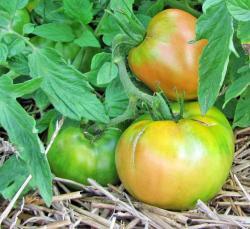 events occur. That helps me avoid the end of the month rush to write something, and remember things I would otherwise forget! Dates of posts (even after publishing) will be in bold type. It is another day when crickets chirp at evening, and Katydids (Scientific Name Tettigoniidae) sing their rasping melody of "Katy did, Katy did". Country dwellers in the Eastern U.S. & Canada know all too well these sounds of mid to late summer. I use to tell myself that summer had grown old whenever these natural music makers began their evening symphonies. Cicadas are the July noise makers with their incessant buzzing in the treetops. They can be heard during all daylight hours of mid-summer. August brings with it an end of Cicada noise, as well as shortened number of daylight hours. It has been relatively dry this past month or so, causing lawns to turn a crispy tan and brown color. Our last mowing before today was July 24th giving us a three week break from lawn mowers. The perennial and vegetable gardens have suffered as well. Rain came Monday and Tuesday of this week giving us a badly needed reprieve from drought conditions. Most perennials have finished the season of bloom while the late summer ones show promise after recent rainfall.
events occur. That helps me avoid the end of the month rush to write something, and remember things I would otherwise forget! Dates of posts (even after publishing) will be in bold type. It is another day when crickets chirp at evening, and Katydids (Scientific Name Tettigoniidae) sing their rasping melody of "Katy did, Katy did". Country dwellers in the Eastern U.S. & Canada know all too well these sounds of mid to late summer. I use to tell myself that summer had grown old whenever these natural music makers began their evening symphonies. Cicadas are the July noise makers with their incessant buzzing in the treetops. They can be heard during all daylight hours of mid-summer. August brings with it an end of Cicada noise, as well as shortened number of daylight hours. It has been relatively dry this past month or so, causing lawns to turn a crispy tan and brown color. Our last mowing before today was July 24th giving us a three week break from lawn mowers. The perennial and vegetable gardens have suffered as well. Rain came Monday and Tuesday of this week giving us a badly needed reprieve from drought conditions. Most perennials have finished the season of bloom while the late summer ones show promise after recent rainfall.
Vegetables have been productive and plentiful in spite of the dry conditions of July and early August. Snap beans, turnips, sweet corn, cucumbers and tomatoes have done remarkably well. Many, many batches of all vegetables have been shared with neighbors and a food pantry sponsored by a local country church. It is worthwhile knowing that others are benefiting from our love of gardening, and the personal satisfaction it brings. The following are pictures of some vegetables that have done well this year.

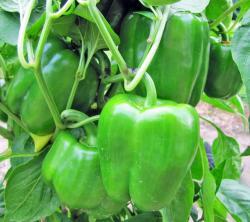


Of course all gardeners pay attention to weather conditions. My records of unofficial rainfall in July barely amounted to 1.6 inches for the month. This is hardly adequate for healthy growth and development of all plants, trees included. Yet we seemed to have dodged the proverbial "bullet": And I think heavy mulching has helped tremendously. Our sandy loam dries out much too quickly without natural and artificial mulch. Temperatures for the entire summer have been far below average, especially in July and August. Looking back June was very wet and cold. The professional record keepers have confirmed on more than one occasion that our weather patterns for most of the Northeastern U. S. have been 'abnormal' (my word- not theirs.) Now we are being told there is to be an above average temperature shift for the balance of August. My thoughts: Wait and see. Meanwhile here are more pictures from August. I cannot go away from summer without pictures as a means of record keeping. One of these is of the dreaded Horned Tomato Caterpillar!


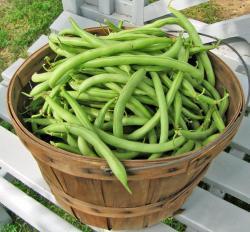


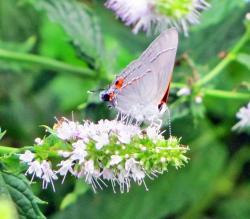 Today, August 15, marks almost the half way mark through the month. Among insects, birds, plants and other wildlife we can sometimes find subtle hints that summer is growing old. Field corn and soy beans have grown to maturity with full ears and pods. Corn silks have blackened and dried. I've noticed an increase in honey bee activity, especially on the clovers and Queen Ann's Lace. Butterflies of all sorts are in abundance on the Monarda, annual blooms and Butterfly Bushes (Buddeleja davidii). I've never really taken the time to appreciate the different types and species of butterflies before, except perhaps to acknowledge their presence in the gardens. Then I read of others' experiences and expertise in identifying them by their proper names. The one shown at the left and right is known as a Gray Hairstreak, or more correctly, "Strymon melinus". Good Web sites are available for identification purposes. A good one for me is BUTTERFLIES. This is a very helpful and informative site.
Today, August 15, marks almost the half way mark through the month. Among insects, birds, plants and other wildlife we can sometimes find subtle hints that summer is growing old. Field corn and soy beans have grown to maturity with full ears and pods. Corn silks have blackened and dried. I've noticed an increase in honey bee activity, especially on the clovers and Queen Ann's Lace. Butterflies of all sorts are in abundance on the Monarda, annual blooms and Butterfly Bushes (Buddeleja davidii). I've never really taken the time to appreciate the different types and species of butterflies before, except perhaps to acknowledge their presence in the gardens. Then I read of others' experiences and expertise in identifying them by their proper names. The one shown at the left and right is known as a Gray Hairstreak, or more correctly, "Strymon melinus". Good Web sites are available for identification purposes. A good one for me is BUTTERFLIES. This is a very helpful and informative site.
Other pictures that I've taken recently include many of the common species seen locally. Even now I'm still learning the proper and common names so there might be a few discrepancies here and there. The first one is an Eastern Yellow Tiger Swallowtail. The second is yet unidentified. The third is known as a Painted Lady, and the fourth is a Silver Spotted Skipper.
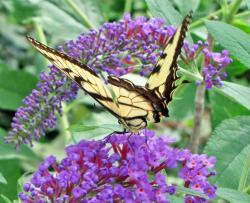
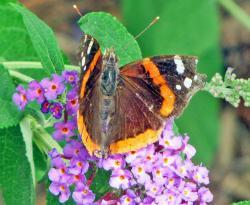

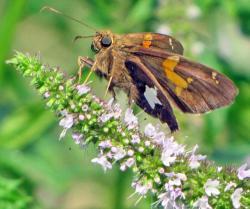
 August 16, 2014 Here it is Saturday already, and I have
August 16, 2014 Here it is Saturday already, and I have 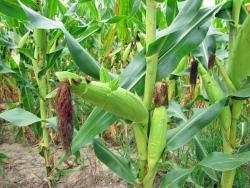 that feeling the month is passing too quickly: Somehow I need it to slow down so all these 'summery' things can be more appreciated and enjoyed. I know beyond a doubt what lies ahead in the late months of autumn! Today's highlights included picking tomatoes and cucumbers, topping Big Daddy onions and removing tomato horn worms from some of the plants. These pests have a more common name in the moth stage of metamorphosis known as five-spotted hawkmoth. Their scientific name is something I wouldn't dare verbalize, let alone spell it: "Manduca quinquemaculata" for those who enjoy a good verbal challenge. The perennial beds have pretty much become void of daylily color, while the rubrum speciosums have brightened the spots where other blooms once graced the gardens. A lot of time has been spent just removing degraded flower stems and dead wood on roses and other shrubby plants. I will probably end today's post here with a few added pictures. An added word of explanation of the onions above at left. Those are Big Daddy long storage onions which I spread on a bed of pine straw and cones for curing and drying. Once dried and safely cured they go into the cellar for cold storage later this fall. I plan to come back to this post if new events, pictures or anything noteworthy comes along. Best wishes to all ATP members for the coming weeks as summer moves on.
that feeling the month is passing too quickly: Somehow I need it to slow down so all these 'summery' things can be more appreciated and enjoyed. I know beyond a doubt what lies ahead in the late months of autumn! Today's highlights included picking tomatoes and cucumbers, topping Big Daddy onions and removing tomato horn worms from some of the plants. These pests have a more common name in the moth stage of metamorphosis known as five-spotted hawkmoth. Their scientific name is something I wouldn't dare verbalize, let alone spell it: "Manduca quinquemaculata" for those who enjoy a good verbal challenge. The perennial beds have pretty much become void of daylily color, while the rubrum speciosums have brightened the spots where other blooms once graced the gardens. A lot of time has been spent just removing degraded flower stems and dead wood on roses and other shrubby plants. I will probably end today's post here with a few added pictures. An added word of explanation of the onions above at left. Those are Big Daddy long storage onions which I spread on a bed of pine straw and cones for curing and drying. Once dried and safely cured they go into the cellar for cold storage later this fall. I plan to come back to this post if new events, pictures or anything noteworthy comes along. Best wishes to all ATP members for the coming weeks as summer moves on.

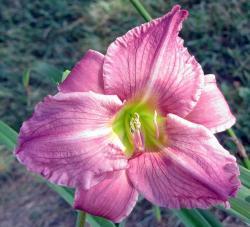


August 17, 2014This week-end brought out butterflies over much of the area. Along roadsides they could be seen on native plant blooms including Joe Pye Weed, Sun Flowers and Queen Ann's Lace. A country drive on one lane roads today revealed much about natural plants and their provision for wild life, especially insects. I plan another excursion this week with camera in hand, hopefully to bring back some pictures. Any good ones will be posted here of course. Meanwhile a new butterfly in my back yard was identified as a King-Thoas Swallowtail. It is a beautiful black and yellow color which is difficult to photograph because it rarely is ever still! Its wings seem to be in perpetual motion. I am posting some of my pictures here: However, I am also posting a link here for this beautiful insect. KING-THOAS SWALLOWTAIL My pictures follow below.
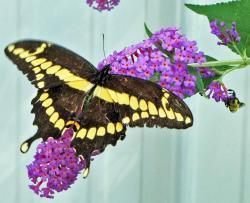
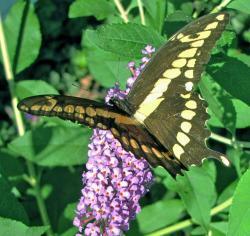
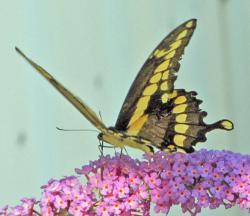
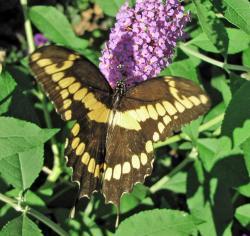
Post a new thread about this blog entry: